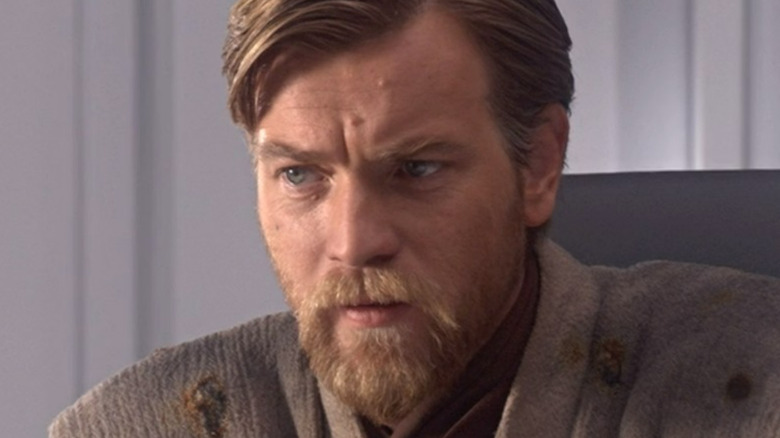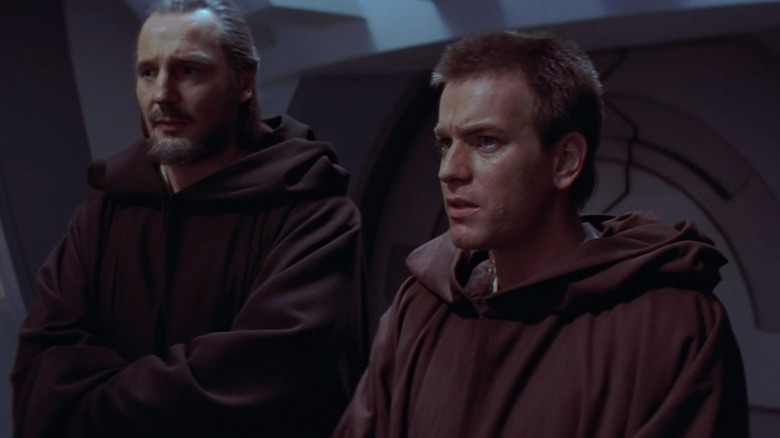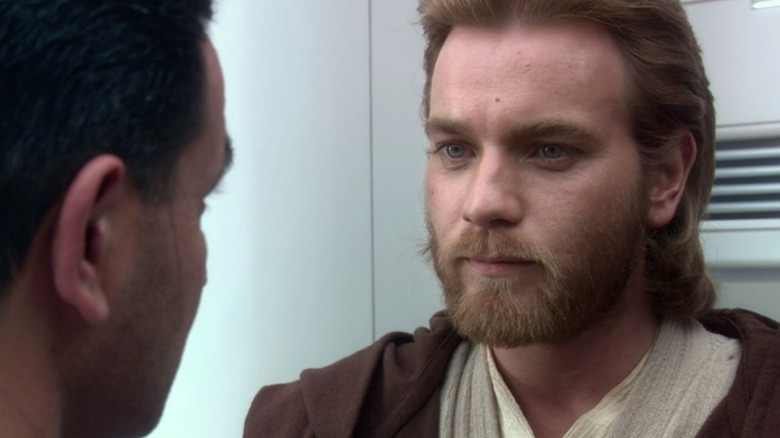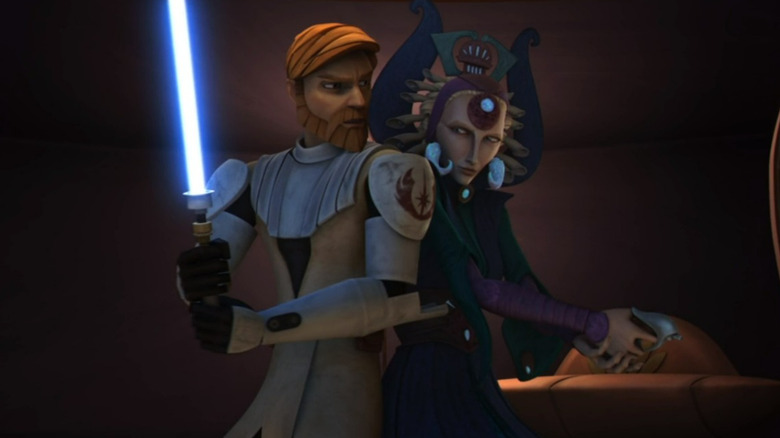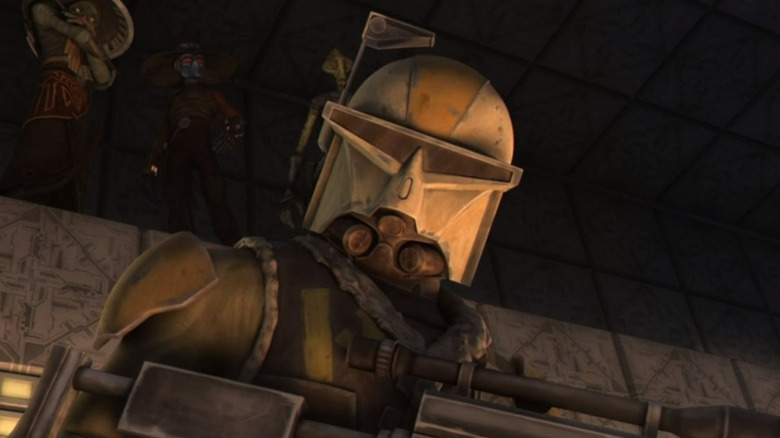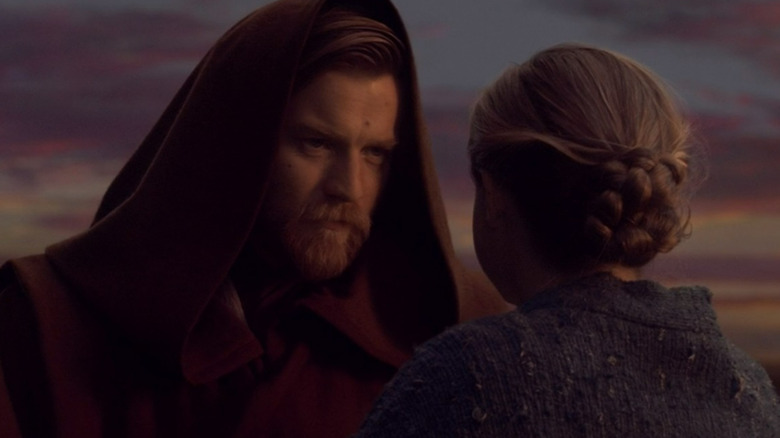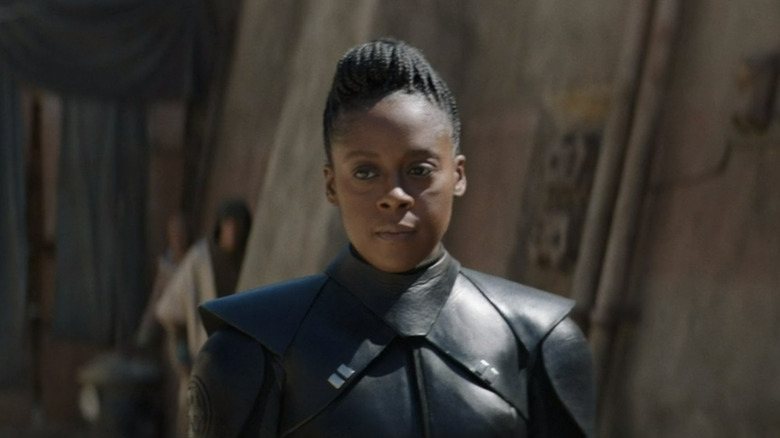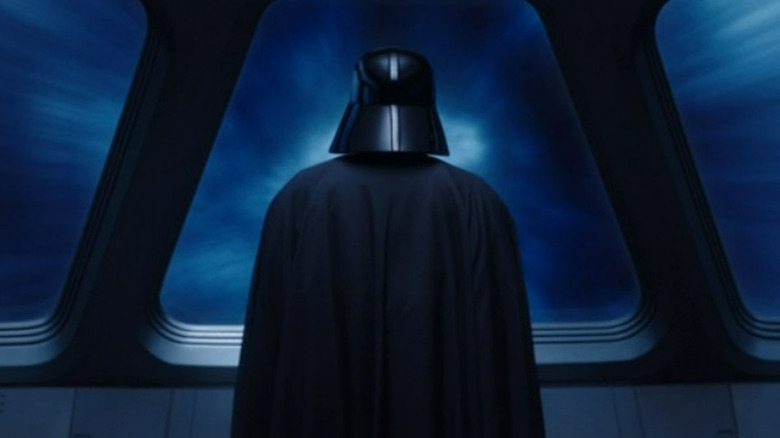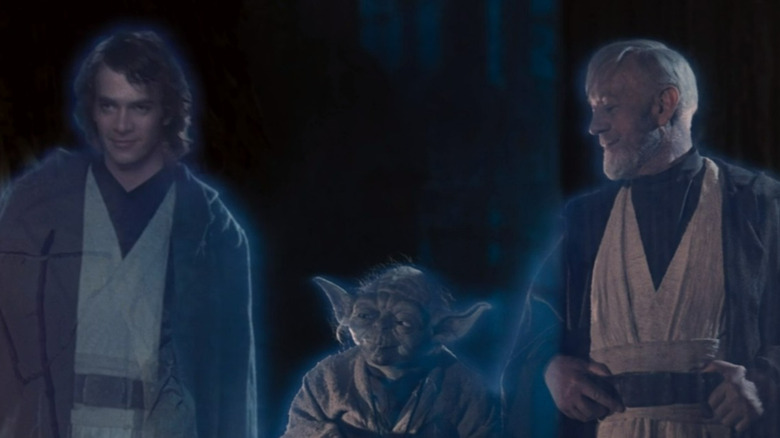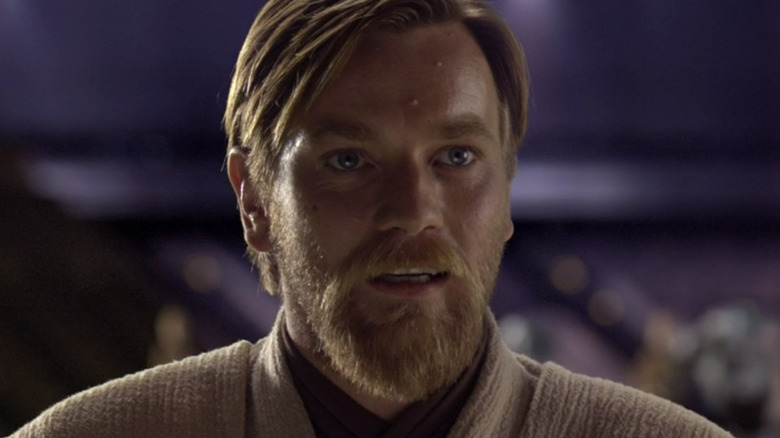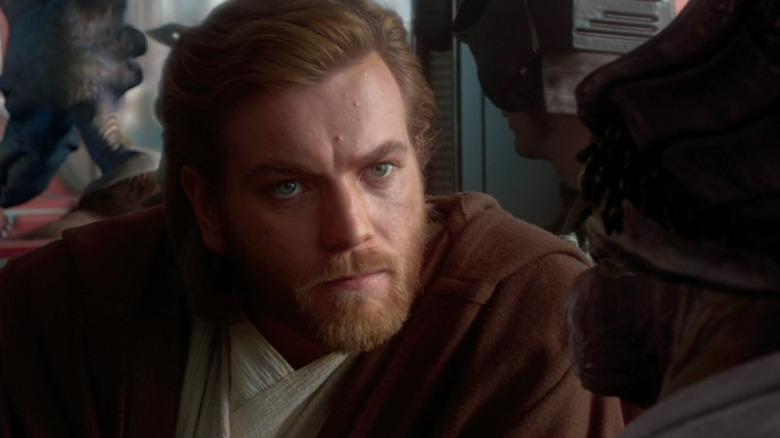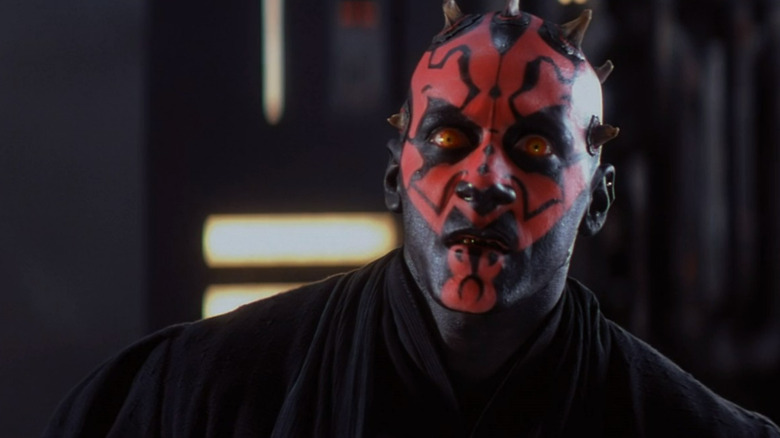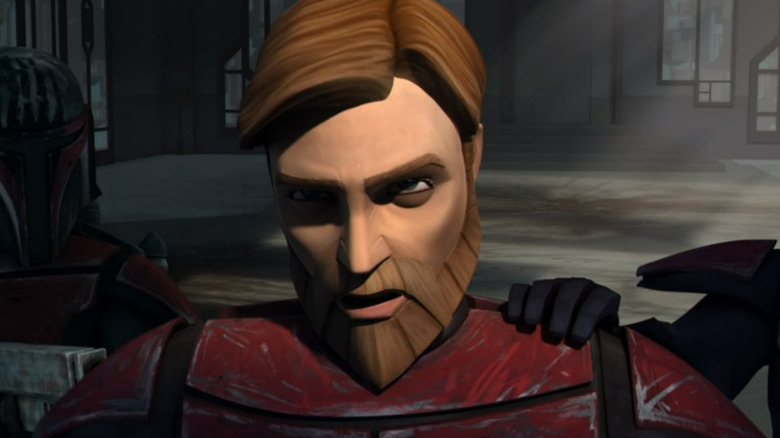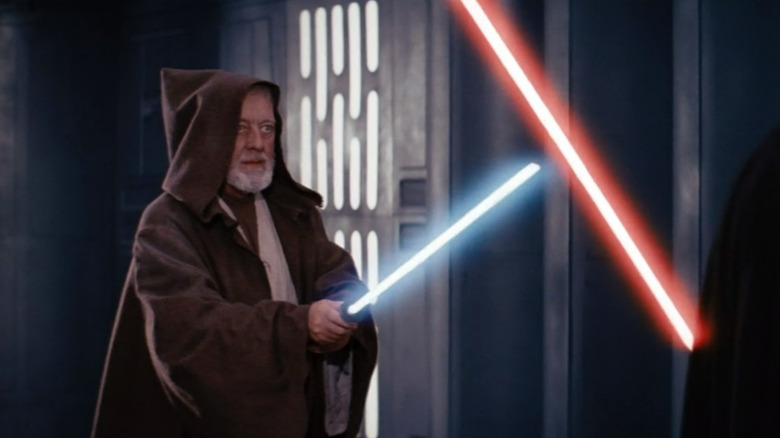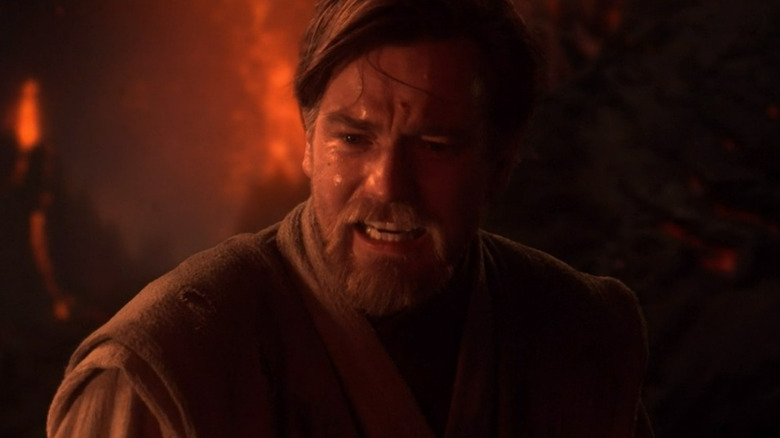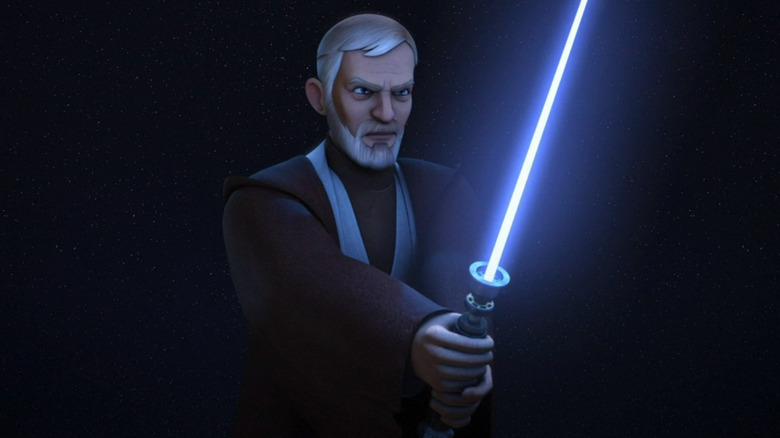Obi-Wan Kenobi's Best Star Wars Moments Ranked
Hello there! If you're a fan of the "Star Wars" franchise, then there's a good chance you're also a big fan of one of its most important characters, Obi-Wan Kenobi. As one of only two characters (if we count Darth Vader and Anakin Skywalker as one) to appear in all six original films and the star of his own Disney+ series, Obi-Wan has played a major role in the "Star Wars" universe, from before the days of the Clone Wars through the end of the Galactic Empire.
Whether you're watching the original trilogy version of the character played by Alec Guinness, the younger Kenobi played by Ewan McGregor, or the animated Obi-Wan voiced by James Arnold Taylor, you're nearly guaranteed to have a good time. From his penchant for snarky one-liners to his habit of getting in and out of sticky situations, Obi-Wan displays a nearly endless stream of exciting, hilarious, and even poignant moments.
But out of all of Kenobi's adventures and the many wars he's fought in, what are the truly shining moments that define the Jedi? That's what we're here to work out. Read on to discover Obi-Wan Kenobi's greatest moments in "Star Wars," ranked.
The first canonical bad feeling
"I've got a bad feeling about this" is one of the iconic catchphrases of "Star Wars," first spoken on screen by Luke Skywalker in the original film and re-uttered in nearly every installment since. But the first chronological on-screen delivery of the line comes from Obi-Wan Kenobi at the beginning of "The Phantom Menace." After successfully sneaking aboard one of the Trade Federation's ships blockading Naboo, Obi-Wan and his master Qui-Gon Jinn discuss the situation and how best to move forward. Obi-Wan, in keeping with his trademark pessimism, has a bad feeling about the whole thing.
This moment isn't emotionally moving, particularly hilarious, or heavy on cool action, but it is significant enough to warrant a mention at the bottom of this list. Somebody had to be the first person in canon to have a bad feeling, and it somehow makes perfect sense that it ended up being Obi-Wan.
Chasing down Jango Fett
It's well documented that Obi-Wan Kenobi hates flying. He states this fact on several different occasions, and yet, he successfully pursues one of the greatest Bounty Hunters in galactic history through space in "Attack of the Clones."
After discovering the Kaminoans' clone army based on Jango Fett's genetic model, Obi-Wan confronts the Bounty Hunter on Kamino. Though Fett escapes, Obi-Wan is quick-thinking enough to plant a tracking device on the ship's hull. He then gets in his own ship and engages in a deadly chase through the asteroid belt of Geonosis, dodging rocks and stray debris while also watching out for Jango's deadly sonic charges.
On the merits of the competition and the stakes, this chase earns a spot on our list. Obi-Wan is all alone, after all, and he uses his wits to outsmart Jango several different times. However, the chase is even more impressive when you consider Obi-Wan's aforementioned distaste for space travel. Pursuing a feared bounty hunter through an asteroid field at high speeds while also being attacked with various weapons is just about as intense as a flight can be, and yet, Obi-Wan navigates the whole situation with skill and poise, leading to another happy landing.
Getting in touch with his feelings
"Star Wars: The Clone Wars" sees Obi-Wan Kenobi undertaking a lot of diverse and dangerous missions, from battling Sith warriors to going undercover as a bounty hunter. One of his primary arcs through the show involves Duchess Satine Kryze of Mandalore, a powerful figure in the galaxy's neutral faction with whom Obi-Wan has a complicated romantic past. At first, their history is only hinted at. Anakin pokes and prods his friend about the time he and Satine spent together in their youth, but Obi-Wan isn't too forthcoming. Eventually, though, the full weight of their connection is revealed.
"Had you said the word, I would have left the Jedi Order," Obi-Wan finally tells Satine in "Voyage of Temptation." It's an admission of many things at once — that he had doubts as a young padawan about remaining in the Jedi Order; that he's struggled with the code's rules about attachment; and that he's still capable of feeling powerfully drawn to another person. Though Obi-Wan and Satine never quite get the timing right, he clearly cares deeply for her, and her tragic death at the hands of Darth Maul is just about as close as we ever get to Obi-Wan crossing over to the dark side.
For all these reasons, and the simple fact that the Jedi usually keeps his feelings pretty close to his chest, Obi-Wan's admission of affection to Satine earns a spot on this list.
Becoming the galaxy's best bounty hunter
In the "Star Wars: The Clone Wars" episode "The Box," Obi-Wan Kenobi goes undercover as a bounty hunter called Rako Hardeen. His mission is to infiltrate a top secret Separatist operation and learn Count Dooku's plans by being hired as a mercenary, but in order to accomplish that task, he needs to prove himself.
The whole episode is a masterclass in why Obi-Wan is such a cool and capable character. Without his lightsaber or any visible assistance from the Force, he must survive and prove himself through an array of deadly challenges. At one point, Obi-Wan even proves himself to be an expert marksman with a blaster, despite famously describing the weapons as "uncivilized" later in his life.
"The Box" is a great Obi-Wan episode because it shows all the different ways he's able to get things done — top-tier combat skills, (at times comical) subterfuge, and a strong ability to think and adapt under pressure. If you love Obi-Wan, this is an episode that's absolutely worth checking out.
Bringing Luke to Tatooine
The end of "Star Wars: Episode III – Revenge of the Sith" is a rough patch for Obi-Wan Kenobi, to say the least. He's betrayed by his own clone battalion, a group he's fought shoulder-to-shoulder with for years, and which is led by a close friend in Commander Cody. Then he has to go into hiding while Palpatine eradicates the Jedi and usurps the Republic's entire system of government. And to top it all off, he has to face off against his best friend and former student, who he was unable to prevent from turning to the dark side.
It's a pretty dark series of events, but in true "Star Wars" fashion, it at least ends with a small spark of hope. Obi-Wan volunteers to take the infant Luke Skywalker to Tatooine to be raised by his step-uncle and aunt. The scene of him handing the child over to Owen and Beru Lars is powerful, and not just because it evokes the nostalgic twin sunset of "A New Hope." It's a major moment for Obi-Wan — an act that symbolizes his enduring love for the Anakin he lost to the dark, and an acknowledgement that while he can't change the past, he can still contribute to a better future.
Letting Reva go
For much of the "Obi-Wan Kenobi" show, Obi-Wan's primary foe is Reva, an Imperial Inquisitor (played exquisitely by Moses Ingram) who is hunting him down. Of course, Reva's true motivation is a bit more complicated than simply wanting to wipe out the Jedi. As a survivor of Anakin's "Revenge of the Sith" attack on the Jedi Temple, she seeks vengeance against Darth Vader, and she believes that using Obi-Wan as bait is the perfect way to get it.
Things don't quite go as planned, however. Reva does confront Vader, but she proves to be no match for him. In a desperate bid to enact some kind of vengeance (thanks to a conveniently dropped audio recording from Bail Organa), she makes her way to Tatooine and tries to kill Anakin's son, Luke. In the end, though, she just can't go through with it.
Reva's story ends in a final confrontation with Obi-Wan — not a fight, but a simple conversation. Obi-Wan commends her for finally giving up on her crusade, and for choosing mercy instead of revenge. It's the kind of council he was never successfully able to give to Anakin, and it's a nice full-circle moment for both characters. After years of hiding in fear and self-hatred, Obi-Wan finally seems to forgive himself by forgiving someone else. And from there, he goes on to become the wise mentor we see in the original "Star Wars" trilogy.
Obi-Wan's second duel with Darth Vader
The "Obi-Wan Kenobi" series culminates in a climactic lightsaber duel between the titular hero and Darth Vader, bridging the gap between their battle on Mustafar in "Revenge of the Sith" and their final fight on the Death Star in the original 1977 film. Ultimately, their second battle doesn't prove to be quite as memorable as either of the others, but it still delivers some great action and a powerful moment of emotional closure between the two former friends.
Unlike the slow, methodical nature of their "A New Hope" fight and the fast-paced frenzy of the Mustafar showdown, Obi-Wan's second fight with Vader is a hard-hitting, close-quarters slugfest. The two advance through rocky terrain while crossing sabers, eventually shifting the focus to a battle of the Force, with Obi-Wan unleashing a brutal display of strength by pelting Vader with boulders and eventually slicing his mask in half.
It's the moment after the fight, though, that really elevates this duel. Seeing Anakin's scarred face and hearing his voice gives Obi-Wan pause, and he tries to reach out to his old friend, but to no avail. "Anakin is gone," Vader says. "I am what remains." And in a dark moment of long-awaited closure, he seems to almost forgive his former master: "I am not your failure, Obi-Wan. You didn't kill Anakin Skywalker. I did." With that, Obi-Wan is able to walk away — saddened, but a little more at peace.
Seeing Anakin redeemed
After everything he went through with Anakin — including eventually being killed by him — it would be fair for Obi-Wan to have given up all hope of his old friend finding redemption. It's unclear if he ever actually believes that all hope for Anakin is lost, but he does seem to be speaking truthfully when he says that he believes his former apprentice is dead. So imagine Obi-Wan's Force ghost reaction when he saw Anakin turn on Darth Sidious, repent for his evil deeds, and help save the galaxy from tyranny.
We don't really get to see it ourselves. The only real moment of on-screen reconciliation between Obi-Wan and Anakin happens when they appear together as Force ghosts during the victory celebration on Endor's moon. It's also fair to question whether or not Anakin's turn back to the light makes up for his decades of violence, during which he murdered children, let's not forget.
That question aside, the moment when Anakin and Obi-Wan are reunited in the afterlife is a high point for both characters. It's just nice to see them back together again after so long being at odds, and it's a particularly vindicating moment for Obi-Wan. Having trained Luke as well as Anakin, he plays a pivotal role in his old friend's eventual redemption. In other words, it's hard to imagine the galaxy being saved without the wisdom and guidance of Obi-Wan Kenobi.
A flashy introduction to General Grievous
There are a lot of heavy emotional moments on this list, which makes sense. After all, Obi-Wan has been at the center of some of the most important events in the entire "Star Wars" timeline. But that doesn't mean that all of his best moments are climactic battles or instances of poignant character growth. Sometimes, Obi-Wan's at his best when he's allowed to be a little bit silly.
Such is the case when Obi-Wan tracks down General Grievous to Utapau in "Revenge of the Sith." Having located the Separatists' hidden base on the planet, Obi-Wan sneaks into Grievous' turf through the rafters, surveying the field of battle droids beneath him. What would a wise Jedi like Obi-Wan do in such a situation, you might ask. Cause a distraction with the Force to even the playing field? Lead the enemy into some sort of trap? While those sound like good ideas, Obi-Wan ultimately decides to go with a different approach — dropping straight down to the ground directly in front of Grievous and declaring his presence with a jolly "Hello there!"
It's goofy. It's cocky. It's very Obi-Wan Kenobi — a character who preaches patience and decries rashness, but who rarely takes his own advice. Ultimately, his plan ends up working, as his own clone forces are waiting for his signal just outside the base. He defeats Grievous and effectively ends the war, all in the style of a true daredevil.
Unraveling the Separatist conspiracy
"Star Wars: Episode II – Attack of the Clones" is often thrown into contention as the worst "Star Wars" movie ever, with its heavy-handed love story between Anakin and Padmé usually being cited as the main failing. However, there are some things about the movie that are undeniably fun, no matter which side of the debate you fall on, and Obi-Wan Kenobi's tenure as a galactic detective is arguably the best part of the whole film.
At the start of the story, Anakin and Obi-Wan are both assigned to help protect Padmé from mysterious attempts on her life. Anakin ends up serving as her bodyguard when she returns to Naboo, while Obi-Wan remains on the mean streets of Coruscant trying to drum up leads. Using the tiny toxic dart employed by Jango Fett to kill Zam Wesell, Obi-Wan manages to unravel most of the Separatist scheme by himself. He uses an old contact in local diner owner Dexter Jettster to get a lead on the Kaminoans, then discovers a hole in the Jedi archives despite being mocked by members of the order. Obi-Wan's unceasing dedication finally leads him to Kamino, and later to Geonosis, from where he's able to alert the Republic to Count Dooku's plans before being captured.
This entire investigative operation is undoubtedly one of Obi-Wan's finest moments, as no one else in the Republic is able to put all the pieces together. Turns out, he makes a pretty good detective.
Defeating Darth Maul the first time
The crown jewel of "Star War: Episode I – The Phantom Menace" is definitely the lightsaber battle between Obi-Wan, Qui-Gon, and Darth Maul on Naboo. It's a fight that deserves a spot in our top five simply on the merits of being one of the best lightsaber showdowns ever, but it's also a major moment in the personal story of Obi-Wan himself.
Trapped behind a laser wall, Obi-Wan is forced to watch while his beloved master is cut down by the Sith Lord. When the laser wall goes down, he's left to face his opponent all by himself. Despite still being a padawan at the time, Obi-Wan manages to pull off a huge upset, slicing Maul in half and knocking him down a shaft, supposedly to his death (though that's later proved to be wrong). It's an incredible display of power, skill, and quick-thinking. It marks Obi-Wan's transition from student to master.
Additionally, this moment is significant because it kicks off the whole Darth Maul vs. Obi-Wan saga — a rivalry that spans decades. Though Obi-Wan's relationship with Anakin is more important to the main "Star Wars" story, his saga with Maul is arguably just as important to his own personal character arc.
Resisting the pull of the dark side
Obi-Wan rarely seems to catch a break. He loses his master in "The Phantom Menace," he's forced to fight his best friend in "Revenge of the Sith," and somewhere in the middle there, he's made to watch the love of his life be brutally murdered by Darth Maul. In the "Clone Wars" Season 5 episode "The Lawless," Obi-Wan returns to Mandalore after Maul takes over the planet in an attempt to save the duchess, but his old rival is a step ahead.
In a powerful scene, Obi-Wan is brought before Maul, who tries to goad the Jedi into turning to the dark side. He presents Satine, taunts the Jedi, and then kills her before Obi-Wan's eyes — all in effort to break his spirit. And yet, while he's clearly stricken by grief, Obi-Wan refuses to yield. "You can kill me," Obi-Wan says, "but you will never destroy me. It takes strength to resist the dark side. Only the weak embrace it."
This moment may well be the greatest test of faith and resolve that Obi-Wan ever faces. He's young when he sees Qui-Gon slain, and he's more saddened than enraged at Anakin's eventual turn. But the Death of Satine is a direct shot to his heart — the destruction of a happy life he can never have, and a reminder of what real pain feels like. And yet, Obi-Wan endures it all without succumbing.
Obi-Wan's final duel with Darth Vader
It's one of the ironic things about the odd chronology of "Star Wars" that Obi-Wan's first on-screen lightsaber battle is his last one canonically. After helping Luke, Han, Chewbacca, and the droids sneak aboard the Death Star, Obi-Wan splits off to dismantle the station's tractor beam so that they can escape with Princess Leia. However, his way back to the Millennium Falcon is blocked by Darth Vader, and the two engage in a third and final duel.
If you're a "Star Wars' fan, you already know how this one ends. Obi-Wan distracts his old apprentice just long enough to ensure that the others escape, and then he voluntarily takes a killing blow from Vader, his body vanishing and his spirit becoming one with the Force. With the context of the prequels and other later stories, this scene is even more powerful. It's the ultimate culmination of Obi-Wan's transformation into the wise master — proof that he no longer needs to fight in order to win. His faith and connection to the Force are so strong that even the threat of death doesn't frighten him, and he faces down Vader with no fear or anger, only confidence.
Obi-Wan's first duel with Darth Vader
While Obi-Wan's final duel with Darth Vader is hugely important, it's not half the spectacle of their first battle on Mustafar. After tracking Anakin down to the lava-ridden planet, Obi-Wan declares his intention to stop his friend at all cost, and the two engage in an epic battle across the hellish landscape.
Yes, this is a moment of narrative and emotional significance, but it mostly earns the number two spot here on the merits of the fight itself. Simply put, it's one of the most exciting and entertaining lightsaber fights in the entire franchise. From the sheer speed of the saber choreography to the creativity in how both combatants use the Force, the Mustafar battle stays taut and fresh from start to finish. And, of course, it ends in victory for Obi-Wan, whose masterful command of the high ground is truly something to be commended.
Leaving Anakin for dead is one of the hardest things Obi-Wan Kenobi ever has to do — both because of the emotional toll it takes on him, and because Anakin is one of the most powerful Force users to ever live. It's a devastating ordeal for Obi-Wan, but he does walk away with the win, as he set out to do.
Defeating Darth Maul for good
It might seem odd to give the number one spot on this list to a Darth Maul moment rather than a Darth Vader one. After all, Vader is far more important to the overall "Star Wars" story, and he's arguably Obi-Wan's most important relationship. And yet, the final showdown between Obi-Wan and Maul in the "Star Wars Rebels" episode "Twin Suns" stands above everything else on this list for a few reasons.
Maul doesn't matter as much in the grand scheme compared to Vader, but he matters immensely to Obi-Wan. He kills Qui-Gon, Obi-Wan's mentor and father figure, and he kills Duchess Satine, the only woman he ever truly loved. He also has next to no redeeming qualities and was never a friend to Obi-Wan in any way. Yet, despite all that, when Maul drags himself to Tatooine seeking revenge, Obi-Wan responds without a hint of anger. "Look what I have risen above," he says in response to Maul's taunting. "If you define yourself by your power to take life, your desire to dominate, to possess, then you have nothing."
Obi-Wan doesn't even draw his lightsaber until Maul threatens Luke. Even then, his restraint is apparent. He begins with his old aggressive stance but quickly changes to a more defensive one, marking his growth. And when Maul attacks, Obi-Wan reads him like a book and lays him to rest with just a couple of simple moves. In this brief scene, Obi-Wan shows that he's made peace with his past and his inner demons, but also that he's still one of the most powerful Jedi to ever live.
